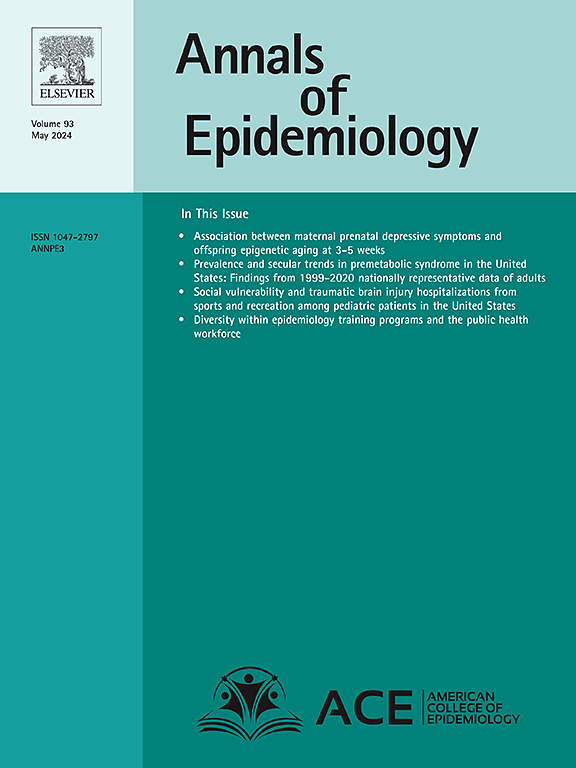Exploring the association between daily distributional patterns of physical activity and cardiovascular mortality risk among older adults in NHANES 2003-2006
IF 3.3
3区 医学
Q1 PUBLIC, ENVIRONMENTAL & OCCUPATIONAL HEALTH
引用次数: 0
Abstract
Purpose
Cardiovascular disease (CVD) is one of the leading causes of death worldwide. Physical activity (PA) has previously been shown to be a prominent risk factor for CVD mortality. Traditionally, measurements of PA have been self-reported and based on various summary metrics. However, recent advances in wearable technology provide continuously monitored and objectively measured physical activity data. This facilitates a more comprehensive interpretation of the implications of PA in the context of CVD mortality by considering its daily patterns and compositions.
Methods
This study utilized accelerometer data from the 2003–2006 National Health and Nutrition Examination Survey (NHANES) on 2816 older adults aged 50–85 and mortality data from the National Death Index (NDI) in December 2019. A novel partially functional distributional analysis method was used to quantify and understand the association between daily distributional patterns of physical activity and cardiovascular mortality risk through a multivariable functional Cox model.
Results
A higher mean intensity of daily PA during the day was associated with a reduced hazard of CVD mortality after adjusting for other higher order distributional summaries of PA and age, gender, race, body mass index (BMI), smoking and coronary heart disease (CHD). A higher daily variability of PA during afternoon was associated with a reduced hazard of CVD mortality, after adjusting for the other predictors, particularly on weekdays. The subjects with a lower variability of PA, despite having same mean PA throughout the day, could have a lower reserve of PA and hence could be at increased risk for CVD mortality.
Conclusions
Our results demonstrate that not only the mean intensity of daily PA during daytime, but also the variability of PA during afternoon could be an important protective factor against the risk of CVD-mortality. Considering circadian rhythm of PA as well as its daily compositions can be useful for designing time-of-day and intensity-specific PA interventions to protect against the risk of CVD mortality.
探索 2003-2006 年 NHANES 调查中老年人每日体育锻炼分布模式与心血管死亡风险之间的关系。
目的:心血管疾病(CVD)是导致全球死亡的主要原因之一。此前已有研究表明,体力活动(PA)是导致心血管疾病死亡的一个重要风险因素。传统上,对体力活动的测量都是自我报告的,并基于各种汇总指标。然而,可穿戴技术的最新进展提供了连续监测和客观测量的体力活动数据。通过考虑日常模式和组成,这有助于更全面地解释体力活动对心血管疾病死亡率的影响:本研究利用了 2003-2006 年全国健康与营养调查(NHANES)中 2816 名 50-85 岁老年人的加速计数据和 2019 年 12 月全国死亡指数(NDI)中的死亡率数据。研究采用了一种新颖的部分功能分布分析方法,通过一个多变量功能Cox模型来量化和了解日常体力活动分布模式与心血管死亡风险之间的关联:结果:在对体力活动的其他高阶分布总结以及年龄、性别、种族、体重指数(BMI)、吸烟和冠心病(CHD)进行调整后,日间体力活动的平均强度越高,心血管疾病死亡风险越低。在对其他预测因素进行调整后,每天下午的活动量变化越大,心血管疾病的死亡风险就越低,尤其是在工作日。尽管全天平均活动量相同,但活动量变异性较低的受试者的活动量储备可能较低,因此心血管疾病死亡风险可能增加:我们的研究结果表明,不仅日间的平均运动强度,而且下午的运动变异性都可能是降低心血管疾病死亡风险的重要保护因素。考虑到PA的昼夜节律及其每日组成,有助于设计针对特定时间和强度的PA干预措施,以降低心血管疾病的死亡风险。
本文章由计算机程序翻译,如有差异,请以英文原文为准。
求助全文
约1分钟内获得全文
求助全文
来源期刊

Annals of Epidemiology
医学-公共卫生、环境卫生与职业卫生
CiteScore
7.40
自引率
1.80%
发文量
207
审稿时长
59 days
期刊介绍:
The journal emphasizes the application of epidemiologic methods to issues that affect the distribution and determinants of human illness in diverse contexts. Its primary focus is on chronic and acute conditions of diverse etiologies and of major importance to clinical medicine, public health, and health care delivery.
 求助内容:
求助内容: 应助结果提醒方式:
应助结果提醒方式:


